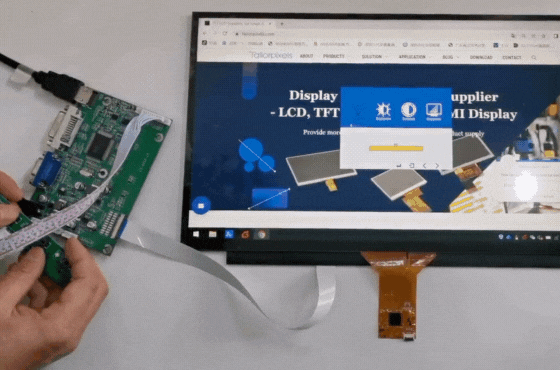There are common concepts often mentioned in the backlight solutions, CCFL, WLED, mini LED, DLED, ELED, PWM. Do you know what they stand for and their technology difference? This article briefly introduces their concepts.
CCFL
The original backlight used CCFL cold cathode fluorescent lamp tubes. Its structure is very similar to that of a fluorescent lamp, with a cold cathode and a very thin tube diameter.
CCFL has the characteristics of high color temperature, high brightness, and good color rendering. But it also has many shortcomings, so it has basically been eliminated now.
- CCFL belongs to tubular light sources, and in order to make the light evenly spread to the display area of the LCD panel, the requirements for the backlight film system are relatively high.
- As the panel size increases, more CCFL strip light sources will be needed. The thickness of the backlight is difficult to control and the structure is also very complex.
- The color gamut is relatively small, and if used as a backlight for LCD, the highest color gamut coverage is only about 72% NTSC.
- Moreover, it has high power, low luminous efficiency, and contains toxic metallic mercury.
WLED
The full name of WLED is White Light Emitting Diode, which is White LED. Compared with the traditional CCFL, the technology has made great progress and is the solution for most LCD screen backlights now. WLED is divided into DLED and ELED backlight structures.
ELED
ELED refers to edge-lit LED, which is a type of LED that installs multiple LED lights at the border of the panel to illuminate the light source from the side. A light guide plate is used to evenly distribute the LED light to the display area.
From the above concept, the DLED is thicker and more energy-consuming than ELED, since the number of LED lights required behind the full panel is definitely greater than the number of LEDs required for the panel frame; the advantage of ELED is that it is thinner and more energy-saving.
DLED
DLED refers to direct-lit LED. Direct-lit products evenly distribute LED lights behind the panel so that the backlight can be evenly transmitted to the entire screen, thereby improving contrast and achieving HDR and better display results.
DLED evenly distributes LED lights behind the panel, so its control of backlight brightness and image quality is relatively better. Using ELED LCD screens, manufacturers need to spend more energy and technology controlling backlight brightness and image quality, which requires higher production and research and development technology from manufacturers, and natural costs are also higher.
Mini LED
Mini LED, also known as a sub-millimeter light-emitting diode, was first proposed by Taiwanese company Epistar. It refers to LEDs with a grain (chip) size of 50-200μm.
Mini LED backlight reduces the size of traditional LED chips. The number of backlight lamp beads has changed from dozens or hundreds to thousands or tens of thousands. The number of partitions can also be increased from dozens or hundreds to thousands or ten thousands, each area corresponds to multiple pixels, combined with regional dimming technology, to perform more refined light and dark control of the backlight.
Without sacrificing brightness, Mini LED backlit LCD panels can achieve contrast ratios of over 1,000,000:1 and higher resolutions. In terms of screen display effect, it can even compete with OLED panels.
It does not mean that Mini LED can definitely kill edge-lit and direct-lit LED. Area dimming is very important. When low-end mini LED backlight displays use zone control technology, the light diffusion per unit zone will affect the surrounding area and cause halo phenomena.
Therefore, how to adjust the halo area to achieve the ideal regional dimming effect is one of the judgment criteria between high-end mini LED and low-end mini LED. This involves the dimming technology mentioned below.
PWM
Pulse Width Modulation (PWM) technology refers to the use of PWM control signals. Its principle is to adjust the luminous brightness of the LED by changing the duty cycle of the LED forward operating current.
PWM can adjust the brightness of the backlight LED in real-time according to the content of the displayed image. That is, when a dark picture is displayed, the brightness of the LED can be appropriately reduced, or even when a completely black picture is displayed, the corresponding backlight LED can be turned off. This not only reduces power consumption but also improves contrast.
PWM technology can be divided into global dimming and local dimming. Local dimming can also be divided into 1D light and 2D light.
Global Dimming
This technology adjusts the brightness of the LED backlight as a whole based on the displayed picture information.
Global dimming technology can be applied to both direct-lit and edge-lit backlight. This type of dimming is commonly used in laptop computers. The disadvantage is that the sync contrast ratio is never greater than the contrast ratio of the LCD panel, which is usually around 1000:1.
Local Dimming
1D area dimming
It is more used on edge-lit backlight panels, and the LED groups on the sides can be controlled independently. This design allows for contrast ratios from 6,000:1 to 100,000:1.
1D local dimming is currently the most common design in HDR TVs and monitors.
2D area dimming
Various manufacturers have different names for this dimming. Some are called checkerboard partitions, or matrix partitions, full array partitions. This design can only be realized on direct-lit LED and mini LED backlight.
2D local dimming produces the best image quality of any of these designs and can simultaneously achieve a contrast ratio of 20,000:1 to 500,000:1.
When it comes to backlight solutions in displays, Tailor Pixels can provide a variety of solutions based on your application and cost control, contact us for more details.
Above are the basic concepts of backlight, explore more you can read below articles:
How to increase the brightness of LCD module? (tailorpixels.com)
How does the LCD Work? (tailorpixels.com)





